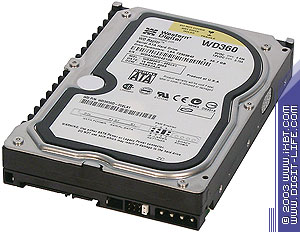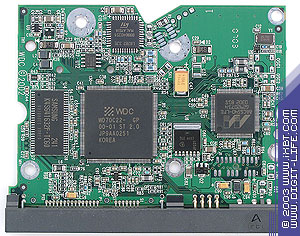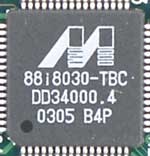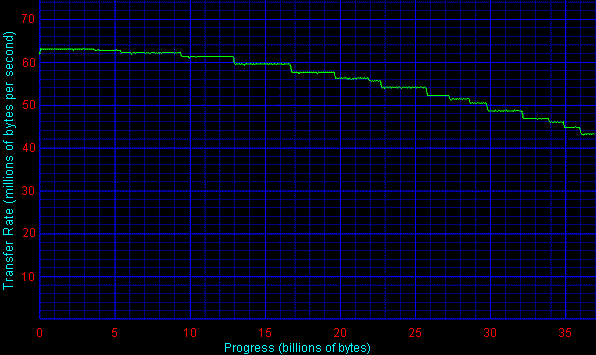 |
||
|
||
| ||
 The revolution coveted by users can be considered to have happened, - this thought comes to my mind when I look at this device. But is that all so necessary for a user? Maybe, the PR experts hold something back? That is why let's try to examine this drive together, especially considering that this model is the first ATA 10K drive. The Western Digital Raptor WD360GD is equipped with the Serial ATA interface. We can witness the birth of the new class of rectangular buzzing boxes - ATA 10K drives. Until recently 10000 revolutions were reachable only for SCSI drives, but they were positioned for the corporate market. That is why average home and office users, who make a bit less than 100%, didn't take to heart the announcements of 10K and 15K drives. Some time ago the dreams about the fastest drive were limited by 7200 rpm. And today users are offered 10K revolutions per minute, plus the last year's dream - Serial ATA interface. The today's aim is to prove or disprove the press-releases, which is possible only through the tests. The problem is not that simple because the drive is the first in its class, i.e. it has no direct competitors. There are actually three lines in the press-release we can proceed from - ATA, 8Mb buffer and 10000 rpm. The WD 2000JB, used as a junior competitor, is one of the best Parallel ATA drives of 7200 rpm with the buffer equal to 8Mb (read more on this drive here). The competitor from above will be a typical SCSI drive Seagate Cheetah 10K.6 (look for the details here). So, here are the photos of the new-comer.
The first thing that catches the eye is cooler's developed fins. Actually, the WD360GD looks more like SCSI drives than IDE models. Well, the design depends mostly on the mechanical part rather than on the electronic one. All the chips but one are located on the internal side of the board.  Here you can see that the buffer size is 64Mbit indeed :)  But the most interesting thing is outside. You can see a chip - it is the only chip there - which is located next to the SATA bracket.  It's marked Marvell 88i8030-TBC. At the Marvell's site this controller is described as Parallel ATA to Serial ATA bridge. I.e. this is exactly the same 10K Parallel ATA drive which has been rumored for two years already! Only with the more up-to-date interface. Now it's clear why it's placed so close to the connector. I wish there were a normal serial interface realized on the drive's controller. But in general, the drive leaves a pleasant impression. Here are the
basic features of all the drives tested today:
Well, the new-comer is closer to the 10K SCSI in its features. Now comes the most interesting part. TestsSince the drives belong to the different classes of interfaces, the testbed can't be the same. The scores of the Parallel ATA drive WD2000OJB were received on the testbed standard for IDE drives. The SATA and SCSI drives were tested on one testbed with the external controllers used. The Ultra/160 SCSI controller was used to make the interfaces' rates as close as possible.
The test software is standard.
Ziff-Davis WinBench 99 / HDTach 2.61 The WD's Raptor has a higher maximum exchange rate than the Parallel ATA but a lower one than the 10K Cheetah (the marketers used to give an aggressive name to something fast and powerful, but what name should be given to the Seagate 5400.1, for example?). A couple of words on Cache off, WB on, and WT on on the diagrams. The SATA controller comes with the Promise's utility which can switch to different modes of operation, i.e. Cache off, and two types of caching - Write back and Write Through. The results for the different modes will be shown on the diagrams only if they are different. In all other cases we set the Write back mode. The access time of the WD360GD is much closer to the SCSI, though it's still inferior. In the WinMark the Raptor with any caching enabled leaves behind both drives in any file system, but remember that this test is Seagate's weak point (see this review). With the caching disabled in the Business WinMark the Raptor steps down, but in the High-End WinMark it keeps its leading position. Well, the diagrams demonstrate it perfectly. Intel IOMeterNow the synthetic tests. Where the SCSI drive goes up the Raptor demonstrates a typical ATA-like behavior. Although it has higher scores, the curve actually looks the same as of the WD2000JB. Well, there is no tag queuing, and the drive can't change the order of execution of instructions. Let's wait for the realization of the true Serial ATA in the drive supporting Native Tag Queuing. The diagrams for the Random Write model look so because of the Write back caching enabled (these access models were not tested in other modes because we couldn't get the idea of the controller in the beginning). Below are the test results in the patterns which were not used before in the tests, for estimating the drives' performance. The tests were carried in the Database pattern (8K blocks), with the read/write ratio changing in +10/-10% steps (from 0% of writing to 100%). The queue lengths were 1, 16 and 256. In case of the linear read/write process (queue = 1) both animals go on a par, and at 100% writing the Raptor makes a good jump ahead. When the queue length's equal 16 the SCSI controller demonstrates its ability to order the queue to make the operation more effective, and at queue = 256 the Seagate outdoes the Raptor by over 1.5 times. Also, the caching doesn't affect the diagrams much. Only at queue = 1 and queue = 16 at 100% writing the WriteBack caching markedly boosts the performance. One more benchmark used for the first time tests performance in case of serial reading/writing. During a short period data blocks of the same size from 512B to 1 MB are recorded/read from the disc. The queue depth is fixed at 4. Here the Raptor performs well - it reaches the maximum write speed at 8-16 KB and demonstrates high performance in case of serial reading, however the scores fall down when the data block is increased up to 256KB and over. The disc/controller tandem doesn't like so big portions to some reason. For the SCSI Cheetah such blocks are not an obstacle. ConclusionSo, the Western Digital's new baby is a good starting point of a new class
of the drives between the Parallel ATA 7200 rpm and SCSI 10K drives. Usage
of such drives in the servers higher than the entry level can be a problem
- the lacking command queuing does not let them work flawlessly at large
loads. But the niche of high-performance workstations can be occupied taking
into account that almost all new boards support the Serial ATA. I just
wish the disc size were greater...
Sergei Bondarenko (mailto:niko@ixbt.com)
Write a comment below. No registration needed!
|
Platform · Video · Multimedia · Mobile · Other || About us & Privacy policy · Twitter · Facebook Copyright © Byrds Research & Publishing, Ltd., 1997–2011. All rights reserved. | |||||||||||||||||||||||||||||||||||||||||||||||||||||||||||||||||||||||||||||||||||||||||||||||||||||||||||